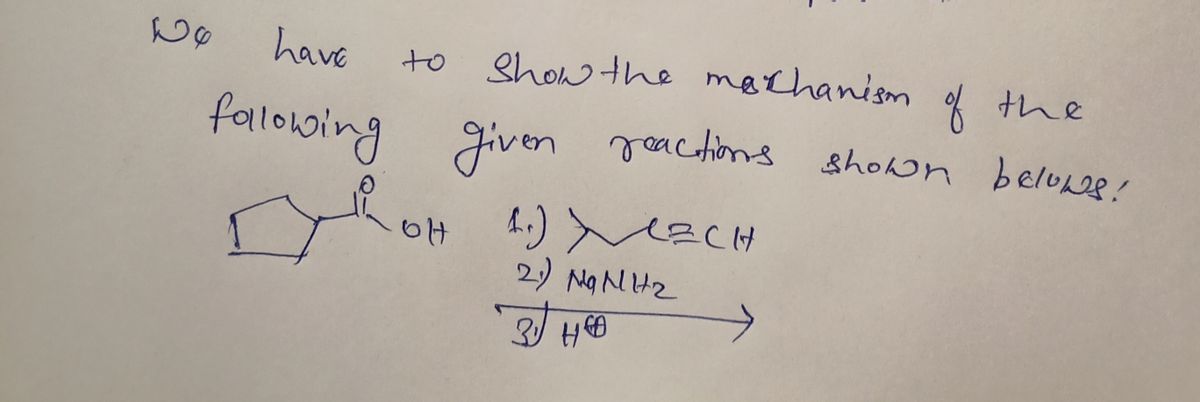Chemistry
10th Edition
ISBN:9781305957404
Author:Steven S. Zumdahl, Susan A. Zumdahl, Donald J. DeCoste
Publisher:Steven S. Zumdahl, Susan A. Zumdahl, Donald J. DeCoste
Chapter1: Chemical Foundations
Section: Chapter Questions
Problem 1RQ: Define and explain the differences between the following terms. a. law and theory b. theory and...
Related questions
Question
Please help me this question! Thank you!
Show the mechanisms of the reactions below

Transcribed Image Text:The image displays a chemical reaction mechanism involving two compounds:
1. **Reactant**: A cyclopentanone with an alcohol group (hydroxyl group, OH) attached. The structure features a five-membered ring with a ketone group (C=O) adjacent to an OH group.
2. **Reagents**:
- Step 1: NaNH₂ (Sodium amide)
- Step 2: H⁺ (Proton source, typically an acid)
3. **Product**: The product is an alkyne, specifically a terminal alkyne with the structure depicted as a triple bond (C≡C) at the end of a straight chain.
**Reaction Explanation**:
- The reaction involves the conversion of a ketone-alcohol compound into an alkyne.
- In the first step, the cyclopentanone reacts with sodium amide (NaNH₂), which likely acts as a strong base to deprotonate the hydroxyl group, facilitating elimination.
- In the second step, the introduction of a proton (H⁺) might assist in stabilizing the resulting structure or completing the elimination process, leading to the formation of the alkyne.
This reaction illustrates a typical transformation in organic chemistry where a ketone is converted to an alkyne through the use of a strong base and acid in subsequent steps.
Expert Solution
Step 1

Trending now
This is a popular solution!
Step by step
Solved in 2 steps with 2 images

Knowledge Booster
Learn more about
Need a deep-dive on the concept behind this application? Look no further. Learn more about this topic, chemistry and related others by exploring similar questions and additional content below.Recommended textbooks for you

Chemistry
Chemistry
ISBN:
9781305957404
Author:
Steven S. Zumdahl, Susan A. Zumdahl, Donald J. DeCoste
Publisher:
Cengage Learning

Chemistry
Chemistry
ISBN:
9781259911156
Author:
Raymond Chang Dr., Jason Overby Professor
Publisher:
McGraw-Hill Education

Principles of Instrumental Analysis
Chemistry
ISBN:
9781305577213
Author:
Douglas A. Skoog, F. James Holler, Stanley R. Crouch
Publisher:
Cengage Learning

Chemistry
Chemistry
ISBN:
9781305957404
Author:
Steven S. Zumdahl, Susan A. Zumdahl, Donald J. DeCoste
Publisher:
Cengage Learning

Chemistry
Chemistry
ISBN:
9781259911156
Author:
Raymond Chang Dr., Jason Overby Professor
Publisher:
McGraw-Hill Education

Principles of Instrumental Analysis
Chemistry
ISBN:
9781305577213
Author:
Douglas A. Skoog, F. James Holler, Stanley R. Crouch
Publisher:
Cengage Learning

Organic Chemistry
Chemistry
ISBN:
9780078021558
Author:
Janice Gorzynski Smith Dr.
Publisher:
McGraw-Hill Education

Chemistry: Principles and Reactions
Chemistry
ISBN:
9781305079373
Author:
William L. Masterton, Cecile N. Hurley
Publisher:
Cengage Learning

Elementary Principles of Chemical Processes, Bind…
Chemistry
ISBN:
9781118431221
Author:
Richard M. Felder, Ronald W. Rousseau, Lisa G. Bullard
Publisher:
WILEY